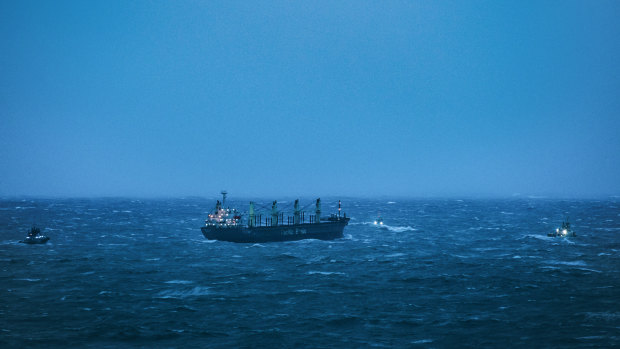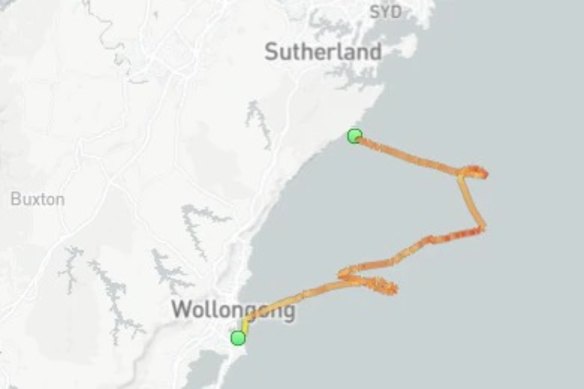This was published 1 year ago
‘They averted a crisis’: Tugboat crew lauded after cargo ship rescue near Sydney
By Ben Cubby
The three-person crew of a tugboat saved the state from disaster on Monday after a stricken cargo ship carrying hundreds of tonnes of fuel oil lost its engine in a storm and drifted powerlessly towards the cliffs of the Royal National Park.
The 169-metre bulk carrier Portland Bay had departed Port Kembla and sailed into dangerous seas. It comfortably withstood the eight-metre, foam-crested waves and 42-knot winds – but then, at 7am, the engine blew.

Three tugboats tow the MV Portland Bay to safety.Credit: James Brickwood
The ship threw down anchors about 1.5 kilometres off the coast between Wattamolla and Eagle Rock, but was bucking in the huge swells. An attempt to rescue the 21-member crew by helicopter was aborted due to the wild weather.
The ship had just unloaded a cargo of cement at Port Kembla, but it carried close to 1000 tonnes of fuel oil, posing a huge ecological risk to the pristine coastline of the national park.
Then the Diamantina arrived. The tiny tugboat grappled to keep the stricken Portland Bay off the rocks for four hours, regularly relinking with the bigger ship when secure lines were torn off by the huge swells until reinforcements arrived in the form of two other tugboats.
“The tug crews are the unsung heroes today,” said incident controller John Finch, of the Ports Authority of NSW. “They have gone above and beyond the call here, battling swells of up to eight to nine metres. They lost a couple of lines but kept going. They averted a crisis. We train for this scenario, and then it arrives. They have done the job.”
The Diamantina’s efforts to hold the ship off the rocks allowed the bigger ship to drop two anchors in the 50-metre deep water off the coast, helping to stabilise it.
Two other tugs, the Bullara and the Martinique, arrived to help further secure the ship and allow it to withdraw its anchors at around 3.30pm. The tugs then towed the still-powerless cargo ship further out to sea so the crew could attempt engine repairs.
“Everything looks positive for the operation at this point,” Finch said. “It has been a successful operation so far, thanks to the team and the tug crews ... Safety is paramount here, protecting the tug crews and the crew on the vessel.”
The Port Authority of NSW said the ship would be towed out to a distance of 12 nautical miles from the coast, where the crew would attempt repairs overnight. It hoped to reach the 12 nautical mile line at around 10pm.
The turbo fan in the Portland Bay’s main engine blew up, causing the emergency, but the ship’s engineers had spare parts on board and would attempt repairs at sea, Mr Finch said.
If not, there was a possibility the ship could be towed to port in the morning for more demanding repairs.
It’s unclear why the engine failed, but Dr Reza Emad, a marine safety expert at the University of Tasmania, said such an event was very uncommon.
“It is very rare, but the crews do train for this, there is standardised training all around the world that they have to complete,” he said.

A map showing the drift of the stricken cargo ship the Portland Bay off the NSW South Coast on Monday.
Bureau of Meteorology data and the ship’s own global positioning system paint a picture of fierce weather, with huge swells, driving rain and winds reaching 42 knots just as the engine cut out. The ship’s tracker then showed the vessel’s course as it veered sharply towards the rocky coast between 7am and 10am.
The bid to rescue the crew by helicopter had been aborted earlier because of wild conditions, said Shane Daw, a manager with the Westpac Rescue Helicopter team.
“The bow was bucking up and down like a bucking horse, a bronco,” Daw said. “The crew tried to get down, but the ship itself was moving up and down 10 to 15 feet in the water because it was powerless, drifting, and the swell was pretty large.
“There were also a series of cranes and structures on the deck and there was a risk of them catching a winch line, creating a bigger problem.”
Dr Emad said the fuel load aboard the damaged ship was a huge concern, but it sounded like the risk had been managed well so far.
“It had just left port and normally it would be bearing a full fuel load,” Dr Emad said. “It’s a risk that has to be managed very, very carefully in that environment. But it sounds like they have done it.”
The Morning Edition newsletter is our guide to the day’s most important and interesting stories, analysis and insights. Sign up here.